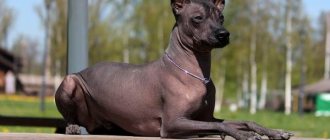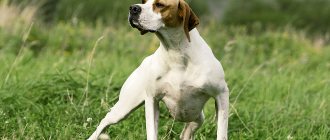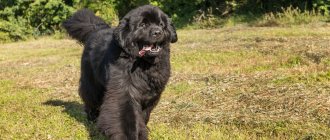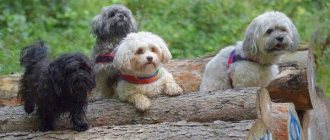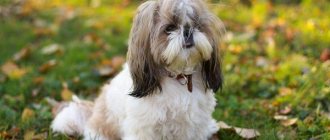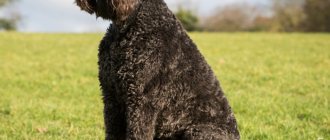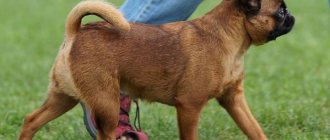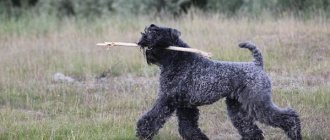- Pets
- >>
- Dog breeds
* Here is a photo of a typical representative of the Miniature Schnauzer dog breed . You can send us photos of your animals by email, and we will post them on the website. Don't forget to send your pet's name.
Other breed names:
Medium Schnauzer, Standard Schnauzer, Schnauzer
Video
* We invite you to watch a video about the Miniature Schnauzer . In fact, in front of you is a playlist in which you can select and watch any of 20 videos about a given dog breed by simply clicking on the button in the upper right corner of the window. In addition, the material contains quite a lot of photos. By looking at them you can find out what a Miniature Schnauzer looks like.
In this article:
|
History of the origin of the Schnauzer
The Miniature Schnauzer is one of the most ancient breeds of schnauzers. The beginning of the breed dates back to approximately the 14th – 15th centuries. The breed was bred in Germany specifically for protection. The literal translation of the word "middle schnauzer" means bearded dog. The reason for the name is quite understandable; the animal has a clearly visible beard on its face. This breed gave impetus to the formation of two others: the Giant Schnauzer and the Miniature Schnauzer. The first name of the breed was Wirehaired Pinscher.
For many years, the Miniature Schnauzer was a farm dog and was used to perform various types of tasks. In fact, this is a fairly versatile dog breed that can perform many useful functions. Famous medieval artists such as Albrecht, Dürer and Rembrandt often depicted dogs of this breed in their canvases.
Interesting fact: Until the 19th century, the Schnauzer was one of the most popular dog breeds in Germany and its neighboring countries. And in 1850, the breed was recognized as the best and purebred by professional breeders and dog breeders in Germany.
The breed received a new name, namely the Miniature Schnauzer, only in 1879. At one of the dog shows, the winner was called Schnauzer. So this name was attached to this breed. And since the beginning of the 20th century this has become a very common name. Although the dog received its first breed standard in the 1880s in Germany precisely as a wire-haired German pinscher. In the beginning, the breed had a large number of colors, but later breeders were able to achieve the basic colors, black and pepper, which became standard for this breed in 1907.
During the First World War, this breed of dog served and was extremely useful. They were both couriers for Red Cross nurses to deliver aid to the battlefield for the wounded, and service dogs for the police.
After the First World War, Germany experienced decline and people migrated in large numbers to various European countries, taking their wealth with them. This list also included miniature schnauzers, which is how the breed came to the countries of Europe and America.
Miniature Schnauzer - description of the breed
Miniature Schnauzers are medium-sized dogs with a strong frame made of wide bones.
Standard breed characteristics:
- The dog's weight is 12-25 kg, height at the withers is 45-50 cm;
- The elongated and wide head, the shape of which resembles a blunt wedge, is equipped with a flat forehead and a bump on the back of the head, as well as a U-shaped jaw;
- Developed cheekbones framed by flat muscles;
- Oval eyes with close-fitting eyelids edged with a dark stripe;
- Semi-erect ears that are set quite high. Some owners decide to crop their ears. However, in a number of countries, ear cropping is prohibited, so the owner of a Miniature Schnauzer needs to take this fact into account.
- Almost square body with a well-developed oval sternum and strong back;
- Medium length neck;
- A high-set saber-shaped tail, which the dog always holds straight. In rare cases, owners dock the tail, leaving 3 parts of the spine. According to the standards, it must be intact;
- Strong paws and well-defined shoulders;
- Black nose with wide nostrils;
- Correct bite of teeth that stand without gaps;
- The coat is of medium length, which consists of guard hair and undercoat. The axial hair is hard and the ends are soft;
- Eyebrows and beard are pronounced;
- Average life expectancy is 14-16 years.
The Miniature Schnauzer has established itself as a cheerful, playful dog that is especially wary of strangers. The dog is very smart and always tries to please its owner, so it is easy to train and can be trained.
Popular colors of miniature schnauzers
Miniature Schnauzers have a thick, coarse coat of medium length and a good undercoat. Wavy and tousled fur is not allowed.
There are two types of coat color:
- Pepper and salt. With this color, each hair is colored with pepper, but the undercoat is gray. There is a dark mask on the muzzle;
- Black. The main hair and undercoat are colored pure black.
The two color types belong to the same breed, but the dogs are bred separately. The nursery breeds only one color. There are cases when individuals of only one color are presented at exhibitions.
Despite the fact that two colors are popular, owners give greater preference to the “pepper and salt” color. Therefore, the likelihood of seeing a Pepper Schnauzer on the street is much greater than a resin one. The calling card of the Miniature Schnauzer is its variegation. This color is recognized as the generic coat of arms of the breed.
The widespread distribution of peppered dogs was greatly influenced by the breeders themselves of this breed. So, pieds began to be bred in Russia ten years earlier than blacks. In addition, black Schnauzers did not have a wide choice of imported progenitors with strong roots.
Interesting fact: Despite the widespread distribution of peppered Schnauzers, it is the black representatives of this breed that are distinguished by their high class and can compete with foreign representatives of the breed.
Today, only two colors of Miniature Schnauzers are declared and no relaxation in this matter is expected from the registry section.
Positive sides
- Attractive and interesting appearance;
- High mental capabilities;
- Loyalty and courage;
- Predisposition to guard duty;
- Good behavior in the house.
Note!
Nicknames for dogs for boys - easy, rare and most beautiful names for dogs in alphabetical order
Nicknames for girls' dogs - a list of beautiful, funny, unusual nicknames for large and small dog breeds
Maltipoo dog - everything about the dog from A to Z. Photos, description of the breed, character, maintenance features, prices, reviews
Character and habits of miniature schnauzers
An energetic and cheerful dog who loves outdoor games, can be very serious and sweet at the same time. The Miniature Schnauzer is particularly devoted to its owner and intelligent, so training these animals is very easy and simple.
A characteristic feature of the breed is stubbornness. During the training process, the owner will have to show perseverance and perseverance in order to achieve the highest quality results. The Miniature Schnauzer is a very smart dog, so it will initially try to take the place of leader in the family. The owner will have to fight this and let the dog understand that his place is “on the mat.” Otherwise, the dog will constantly manipulate the owner.
The dog is ideal for keeping in an apartment, but it also needs regular physical activity. The owner should spend enough time playing with their pets, preferably outside.
Dogs of this breed are very sensitive to harshness from their owners; they are touchy. The hunter's blood still continues to boil in his veins, so they do not get along well with cats and rodents. The exception is a union with another pet from the very birth of the dog. The optimal union is considered to be cohabitation with another individual of the same breed.
Dogs do not allow strangers into their home; the guard instinct is triggered automatically. When an intruder enters the house, the dog first signals the owner about danger, and then independently tries to detain the intruder. The Miniature Schnauzer has established itself as a brave and fearless protector of all family members.
Interesting fact : At the same time, dogs are very affectionate and friendly towards their owner. Their favorite pastime is active play. They will enjoy playing with children.
Life on a chain is not suitable for a Miniature Schnauzer. The dog needs constant activity. If you keep him in an apartment, then he needs to be walked for a sufficient amount of time, at least an hour. If a dog lives in the yard of his house and can independently move around its territory, this does not mean at all that he does not need attention. Play and training are mandatory conditions for the full maintenance of an animal.
Key points in training
For service dogs, special training sets are selected, but if the pet is needed solely as a companion, then a basic course will be enough for it. From the very first days of being in a new home, the puppy is taught the rules of behavior. He is not allowed to snap, bite members of the household, or sleep in his owner’s bed.
The dog needs to remember its name. To make the learning process easier and faster, the nickname chosen is simple and ringing. During everyday situations and training, the puppy is called only as its nickname sounds.
Training should take place under the guidance of an experienced dog handler, because Mittels are stubborn . First of all, the puppy learns to walk in noisy places, suppresses fear, aggression and other negative emotions. The “Dog in the City” program is mandatory for all city pets. It will promote proper interaction between the dog and the owner and teach basic commands (“place”, “sit”, “no”, “near”).
Read about how to properly train a dog in the article: “Training a puppy: effective methods from dog handlers, learning commands at home.”
A method of motivation and encouragement should be used. Mittels do not like harsh measures, they remember the offenders and seek revenge.
Interesting facts about miniature schnauzers
The favorite pastime of dogs of this breed is active games, so they are often completely immersed in the process and get carried away by it. Such behavior makes them uncontrollable; the dog may simply stop obeying the owner during play.
However, the Miniature Schnauzer is not only distinguished by its playfulness. Dogs have a well-developed sense of smell and smell, and at a crucial moment they can be extremely attentive and diligent. That is why they are recruited to serve in the Ministry of Emergency Situations, border services and police. Dogs are excellent at following a person's scent, so they can easily track down criminals or victims. With their help, it is easy to find evidence during investigative activities.
The following facts speak about the specific character of the Miniature Schnauzer:
- Many years ago, dogs were specially kept in stables to catch rats. They dealt with rodents much better than cats. That's why they were called rat catchers or stable pinschers;
- Dogs were active participants in hostilities. They coped well with the role of ambulance dog and signal dog in army units;
- At the end of the 20th century, a miniature schnauzer lived in the White House of the presidential administration, who often performed for visitors. In 1995, he won the title of "First White House Pet" in a competition with Bill Clinton's cat. As a result, the pet received a personal limousine and security. The dog was regularly invited to public appearances, banquets and various events;
- History knows the case of a miniature schnauzer named George, who determined the presence of cancer in a person. Sensing clusters of cancer cells, the dog sat on the patient’s problem area and barked loudly;
- In Germany, the Miniature Schnauzer was erected a monument “The Night Watchman” in 1620;
- The dog can be trained to wipe its beard after eating.
Pros and cons of Miniature Schnauzers
The main advantages of this dog breed:
- A good option for maintaining a home;
- Vitality and unpretentiousness;
- High intelligence. The animal is easy to train;
- Good qualities of a watchman. In any situation, the dog will defend its owner;
- High sports skills. This is an energetic and hardy dog;
- Devotion to the owner and his family;
- Ability to get along with children. Especially loves to play active games with children from his family;
- Excellent coat that makes the dog feel comfortable in any weather. The dog does not get wet or freeze;
- Distrust towards strangers;
- A dog that will find a way to cheer up its owner.
The main disadvantages of this dog breed:
- Manifestation of cunning and manipulation of the owner;
- If the owner shows weakness, the pet tries to dominate him;
- Stubbornness;
- Resourcefulness. If you do not organize leisure time for this dog, it will definitely find something to do that the owner does not always like;
- Impudence. If you give it some slack, the dog will simply sit on the owner’s neck. But it will be difficult to throw her out of there;
- Excessive distrust of strangers;
- The dog needs constant painstaking and expensive care.
The main difficulty of the Miniature Schnauzer's character is its ambiguity. For one owner, distrust and caution towards other people is a positive thing. For other owners, this trait of the animal brings a number of inconveniences. Even a small puppy is ready to defend its territory to the bitter end, not allowing strangers into it.
And everyone around them is considered strangers to this breed, except the owner and members of his family. With age, the dog's guard qualities only intensify. Of course, an adult dog can get used to its owners' friends and, over time, enjoy their presence. But this will take a lot of time.
Theses
- The Miniature Schnauzer is quite intelligent, but can be stubborn. For new dog owners, training can be a daunting task.
- They have a strong protective instinct, but they do not bark without a reason. Only if something happens that requires attention.
- Miniature Schnauzers very quickly lose interest in training if it is monotonous.
- Thanks to their intelligence and dominant character, they understand human mistakes and strive to take a leading position in the pack. Understanding dog psychology and setting boundaries is very important for a dog.
- Schnauzers are suspicious of strangers until they realize that their owners are happy to see them.
- They have a lot of energy that needs an outlet. Otherwise, they will let it go in a destructive direction.
- Since one of the main tasks in the past was the extermination of rats, you should not leave your Miniature Schnauzer alone with rodents and small animals.
- However, they get along well with cats.
- These dogs are curious, fearless and do not like other dogs. When walking, you should not let them off the leash; fights are possible.
Breeding Schnauzers
Mating of dogs of this breed is no different from mating of dogs of other breeds. A female Schnauzer is capable of producing offspring after her first heat, which occurs before she is one year old. But experts recommend refraining from giving birth after the first heat, as this can negatively affect the health of the female. At this age, she is not yet fully formed. The most suitable age for giving birth is 2 years, in which case the threat to the female is minimal, and the puppies will be healthy.
Interesting fact: Signs of pregnancy in the Miniature Schnauzer appear quite late in the pregnancy. The bribe occurs between the eleventh and fifteenth days of estrus.
It is undesirable to feed animals before a bribe. It is best to introduce a male and female for mating on territory that is neutral for both dogs. It is best to do this outdoors, so that the animals can get to know each other well, walk and run around together. But it is advisable to carry out mating on the territory of the male, these are ideal conditions for him. The main thing at this moment is not to disturb them and not to interfere. After 48 hours, it is advisable to carry out a control mating.
The number of puppies for bitches increases with each litter depending on age. Young ones give birth to fewer puppies than older ones. The main thing is to mark the day of mating, in this case it will be possible to control the gestational age. After all, giving birth too early or too late can negatively affect the health of the puppies.
Since pregnancy manifests itself late, it can be determined by the dog’s behavior. A pregnant female becomes calmer and more affectionate. From ignorance, you may get the feeling that she is sick.
For childbirth, you need to prepare everything you need:
- Disposable diapers or sheets;
- Sterile wipes;
- Afterbirth bowl;
- A large number of rags, maybe not new, but always clean and ironed;
- Basin or box;
- Antiseptic;
- Medicines in case of unsuccessful birth.
Females give birth to puppies between 58 and 63 days. Before giving birth, your dog's stomach needs to be cleaned, so you will need to give her a laxative. A couple of days before giving birth, the dog’s body temperature drops to 37°C.
Mating
Experienced breeders try to breed dogs in late summer or early autumn so that puppies are born in the autumn-winter period. It is believed that this way the dogs will be stronger and more resilient. They begin to breed animals after full puberty (at 20-25 months). At this time, the female begins her third heat. Favorable days are 13-15 from the beginning of the cycle.
Experienced girls themselves know when to let a dog in. The owner needs to watch for signs. When the discharge becomes lighter and the loop loosens, ovulation begins. Even after mating, the owner must record the duration of pregnancy or pause (if mating did not take place).
A few days before the heat, the female is registered at the club in order to find an advantageous match (the male complements the female’s shortcomings and vice versa). Owners fill out paperwork, set a meeting date, and set a specific price.
The animals are brought together in a spacious neutral territory (or at the male’s house). They are given time to get to know each other. It is best to walk the dogs together in advance. When the girl is ready and the boy is ready, the owners should help the pets sit comfortably and steadily. The females are held under the belly, and the males are directed into the loop. Repeat knitting every other day.
The first signs of pregnancy appear after a couple of weeks. The dog becomes restless, goes to the toilet more often, and asks for more food.
Specialists will be able to confirm the status only in 3-4 weeks using an ultrasound or test. At this time, it is important to avoid false pregnancy and not confuse the fetus with peometra (inflammation of the fallopian tubes).
Read a detailed article on the topic: “Everything you need to know about breeding dogs: appropriate age, what to do if it doesn’t work out, rules and tips.”
Caring for Miniature Schnauzers
The Miniature Schnauzer is a medium-sized dog, which means it can be kept in an apartment without any problems, but only with regular walks. This breed has a developed undercoat, so the dog can be kept as a guard dog in the yard. The Miniature Schnauzer, like other dog breeds, requires care.
The list of procedures that a dog needs includes:
- Cleaning wool;
- Periodic regular bathing;
- Haircut and trimming;
- Regular examinations of eyes, ears, teeth;
- Trimming nails as needed;
- Cleaning the eyelids.
Trimming and hygienic haircuts must be carried out at least twice a year. They mainly cut the hair in the area of the muzzle, paws and groin area. At least once a week, the coat should be cleaned and combed with a comb and a special brush.
When examining the eyes, it is necessary to pay attention to the mucous membrane of the eye and the secretion of tears. Ears should be cleaned once every one to two weeks. Claws are trimmed on average once every three weeks. An important point concerns the animal's fur. About twice a year it becomes soft and loses color. In this case, it must be plucked out so that a new and beautiful one grows. This does not cause the animal any pain.
A distinctive feature of the Miniature Schnauzer breed is its beard, and it requires maximum care. The beard should be combed daily and washed after each meal so that there are no pieces of food left there that can cause skin diseases.
The Miniature Schnauzer can be fed with both special food and natural food. In both cases the food must be of high quality. If you feed natural food, then the menu should include meat, offal, cereals, various vegetables and herbs. You can also add dairy products and eggs to your diet.
External parameters
- Strong, not particularly long neck;
- The head is elongated;
- Rounded eyes of dark color;
- Shaggy eyebrows;
- Thick and long beard;
- Stocky and dense build;
- Muscular legs;
- Coarse wool;
- The paws are round in shape.
Like other dogs, Schnauzers have positive and negative sides.
Miniature Schnauzer diet
Miniature Schnauzer puppies can eat both dry food and regular food. A small Schnauzer may not always like dry food and he will not eat it. Accordingly, you need to conduct several tests before purchasing food in large quantities.
If the owner is going to feed the baby natural food, then it is worth remembering that for normal development and growth the dog needs a balanced amount of proteins, carbohydrates, fats, minerals and vitamins. This means that his diet should consist of products containing this entire set.
You can get protein for your baby by feeding him milk, meat or fish, as well as cereals. Meat and fish will provide your pet with fats. To normalize the functioning of the dog’s muscular system, its menu should contain vegetables, rye or wheat bread, as well as various cereal products. To replenish the body's reserves of minerals and vitamins, the baby needs to be fed liver, dairy products and fruits.
As for the drinking regime, the water in the drinking bowl should always be clean and constantly change. The water should not be cold or very hot. A Miniature Schnauzer puppy, one and a half months old, is fed on average 4 – 5 times a day.
His daily menu is as follows:
- Meat;
- Cottage cheese;
- Porridge (rolled oats or buckwheat);
- Fermented milk products (kefir or yogurt);
- Vegetables;
- Sour cream;
- Vegetable oil.
One meal should not exceed 80 g in weight. Upon reaching two months, the norm for one meal is 160 g. Until 10 months, puppies’ food must be crushed, and the portion size gradually increased to 240 g.
Important fact: From the age of one year, the puppy must be switched to adult food, taking into account its anthropometric parameters and physical development. Regardless of age, the dog needs to be given additional medications containing salts, phytin and calcium, as well as vitamins. All these drugs are given to the animal on a monthly schedule.
In order for the use of drugs to be as effective as possible, it is necessary to consult a veterinarian before use and undergo the necessary tests, on the basis of which the doctor will prescribe a dosage. Otherwise, you may exceed the dosage, which will lead to negative health consequences.
How to choose a puppy
Puppy with owner
- Assess how well the puppy's appearance meets the standard requirements, but don't get too hung up on it. It is extremely difficult even for a specialist to guess the future champion in a two-month-old baby.
- Measure the puppy's height and weight. At two months, a male Schnauzer must be at least 28 cm at the withers, and his weight must not be less than 4 kg. "Girls" are usually shorter and lighter.
- When meeting your little Schnauzer for the first time, carefully monitor his reaction. Preference is given to brave, inquisitive, nimble people who are willing to make contact.
- It is great if the breeder shows you the father of the puppies, but this rarely happens. Do not miss the opportunity to at least look at the bitch, as well as evaluate her temperament and habits, which the offspring will most likely inherit.
- If you are offered puppies from the first litter of a young bitch who did not have time to acquire prestigious diplomas, do not hesitate to inquire about the exhibition achievements of her ancestors.
- A litter inspection report, which is available in every self-respecting nursery, helps a lot in choosing a puppy. Request this document from the breeder and carefully read the results of the conclusions. If almost half of the newborn Schnauzers were rejected by the club specialist, it is better to avoid such a kennel.
- A correct Miniature Schnauzer should not have any signs of a hernia on its belly. Dirty fur, bad breath from the puppy, and a swollen belly indicate that the breeder does not put too much effort into caring for the pets.
Diseases and health problems
There are three types of infectious diseases that can affect this breed of dog:
- Viral (appears when the dog has either not been vaccinated against this disease or has been vaccinated incorrectly);
- Bacterial (diseases that spread to the animal’s skin);
- Fungal (spread to the skin and hair).
Tick bites are also quite dangerous for the animal, which can lead to diseases such as piroplasmosis or babesiosis, which are deadly for the animal. If your pet exhibits any suspicious behavior that does not resemble its usual behavior, you should immediately contact a veterinarian; perhaps this will help prevent the development of the disease at earlier stages by diagnosing it in time.
The main distinguishing features of the disease are: lack of appetite, dry nose, digestive tract upset, excessive salivation, cramps or convulsions, weakness, apathy, increased or, conversely, decreased body temperature, change in color of mucous membranes.
In general, Schnauzers are a fairly healthy breed of dog, but they also have their own diseases:
- Atopy is an allergic disease accompanied by itchy skin caused by substances in the environment;
- Melanoma is a tumor;
- Lipomas are tumors in the fatty subcutaneous tissue, usually benign;
- Bloating – with this disease, twisting of the intestines is possible, which is extremely dangerous for the animal;
- Hip dysplasia is an inherited condition that causes lameness;
- Epilepsy - manifests itself during the period of life from 2 to 5 years of life;
- Cataract - affects the eyes and leads to blindness of the animal;
- Cryptorchidism is a disease in which one or two testicles do not descend;
- Diabetes is a disease in which the pancreas does not secrete enough insulin;
- Pancreatitis is inflammation of the pancreas. Most often accompanied by abdominal pain and loss of appetite.
Miniature Schnauzers also have bladder infections, and unneutered males have testicular tumors.
Haircut with clipper
Mittels should never be fully clipped. Such manipulation can have adverse consequences:
- Violation of the structure of the coat;
- Change in color: dullness, expressionlessness, shapelessness;
- Impossibility of full hair growth;
- Subsequent matting and hardening of the wool;
- Lack of healthy shine.
Grooming of Miniature Schnauzers is permitted only after manual removal of old and dying hair. This procedure is carried out against hair growth.
Places that can be shaved:
- Genitals;
- Whiskey;
- Throat;
- Ears;
- Stomach.

